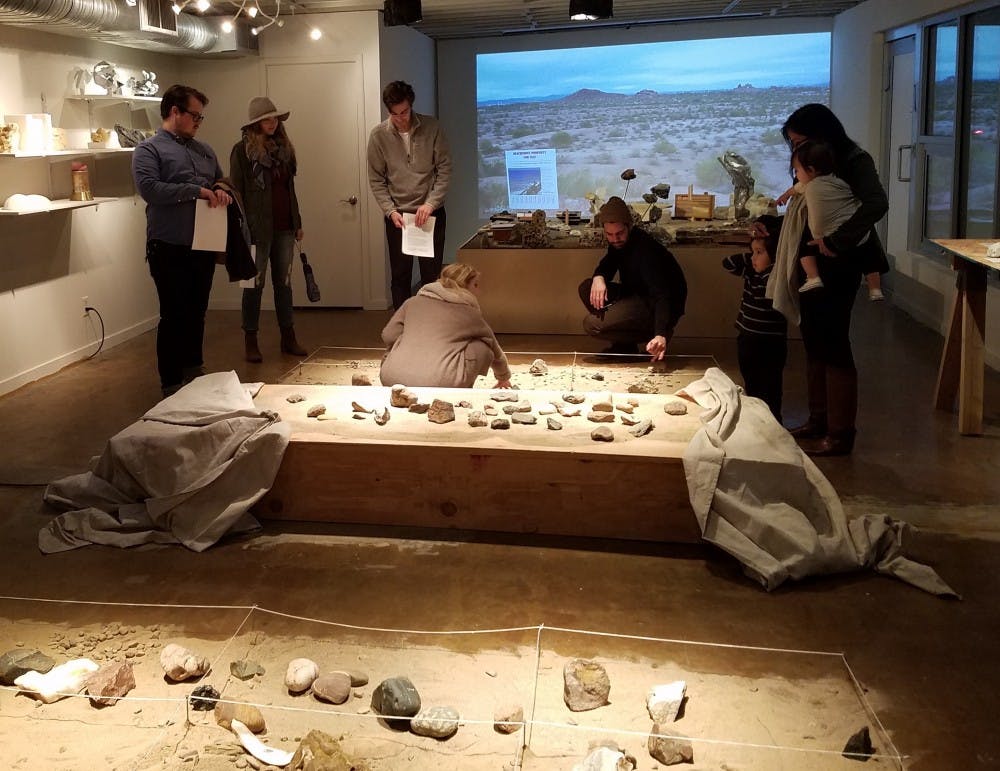This is the last chance to purchase a trendy beachfront property in Arizona. Time/Shores, an art exhibit on display at the Downtown campus, opens up for its last Third Friday tomorrow. The exhibit seeks to engage the public in a discussion about desert sustainability through an interactive exhibit that incorporates satire.
The Feb. 17. installation is presented as a collaboration between Laboratory for Critical Technics and the ASU Art Museum's faculty spotlight series. The exhibition, created by two ASU professors, utilizes multimedia components of sculpture, video and interactive audio to invite viewers to consider the ecological and social implications of humanity's interactions with the desert.
"Sustainability is on everyone's mind, and it is particularly important at ASU," said Stacey Moran Nocek, a member of the Laboratory for Critical Technics and a lecturer with the school of Arts, Media and Engineering. "We want to use our humanities lab as a trans-disciplinary space to engage students around campus and around the world in these issues through creating art."
The Time/Shores exhibition is intentionally housed in a "small and intimate room," made of three main components a visitor sees as soon as they step in.
The first fixture consists of three raised boxes of sand and stones on the floor, in the style of a typical archaeological dig. This is where the interactive portion begins — if viewers pick up one of these stones, they will begin to hear the sound of water.
Ocean sounds seem out of place in downtown Phoenix. However, according to geologists, Arizona was completely underwater and home to aquatic life until about 251 million years ago. Due to increasing concerns regarding rapid climate change, scientists predict Yuma may again be underwater in less than 1,000 years.
Ron Broglio, a co-creator of the show and an ASU English and ethics professor, said it is important to remind viewers of Arizona's cyclical relationship to the ocean.
"This place has seen water before, and is going to see water again," Broglio said. "Our time here? This is just a small intermission."
The next part of the art piece is the line of shelves in the room, which display worn-down versions of frequently used, everyday objects with small, museum curator tags satirically speculating about their function. For example, viewers can see a portable fan described as a "spiritual totem object."
"These are objects that are unearthed by historians in the 'next future,' trying to figure out what people in our time would've used them for," Broglio said. "It's very playful speculative archaeology. We're asking the question: What would the future think about our present?"
The third fixture is the two TV screens, occupying the left and back walls. Both play videos on loop that reference and satirize disaster capitalism. Disaster capitalism tries to take the collapse of a city, culture or moment and profit by speculating what can be gained in the future.
"We're playfully selling beachfront property at great prices for Arizona in 1,000 years," Broglio said. "We are examining the strangeness of how capitalism works in the relationship to disaster and the idea that humans will even still be around to profit in the event of a catastrophe like this."
Although Arizona isn't projected to be underwater for at least another 1,000 years, Broglio pointed to the current political rhetoric surrounding environmentalism to explain the importance of discussing this issue.
"Some of the decisions that are made have incredibly long-term effects long beyond any one generation," he said. "Time/Shores looks at implications – it collapses time between the short-term and the longer now in geological thinking."
Kev Nemelka, an ASU contemporary art theory senior who works with the Project Space, said by having such an interactive and humorous exhibit, he hopes to make people feel more comfortable approaching contemporary art.
"This is a very interdisciplinary piece — it incorporates computer technology, art, sustainability and several other fields," Nemelka said. "It seems like a stretch to combine all of those things, but that's what ASU likes to do — challenge these dichotomies we have created between fields."
The Time/Shores exhibit will be free and open to the public for the last time Friday, Feb. 17. from 2 p.m. to 9 p.m. The last chance to see the piece before it travels abroad will be during the Symposium on Slow Time event occurring on Feb. 24.
The symposium will consist of presentations and workshops dealing with the issue confronted by Time/Shores from the contributing artists and members of the Laboratory for Critical Technics.
If you're interested in attending, please email adam.nocek@asu.edu to RSVP for the workshops.
Reach the reporter at cagoldin@asu.edu or follow @auruming on Twitter.
Like The State Press on Facebook and follow @statepress on Twitter.




